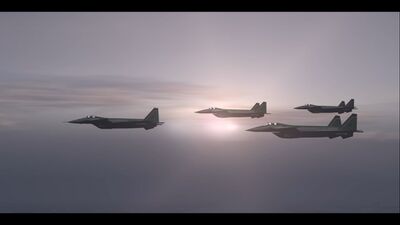Operation Nyktophylax
Operation Nyktophylax ("Night Watch"), also known as the Kotoryn Raid, was an air attack carried out by the Commonality Air Force during the Zemplen War on 23 October 2009 against the Ruvelkan Kotoryn Air Base.
On 22 July 2009 the Ruvelkan Imperial Air Force had commenced Operation Eclipse in response to Ruvelkan losses during the Syaran Spring Offensives. Ruvelkan AFSB-2 Spettro Strategic Bombers, originally built in Cacerta and also flown by Syara as the Ceyx, took off from air fields in central and eastern Ruvelka, flying through the Sundering Sea or covertly through the airspace of Mansuriyyah to launch strikes against Syaran logistical centers and industrial capacity. Syaran efforts to intercept these attacks were met with mixed results as the Commonality Air Force struggled to take down the high flying, fast moving Spettros who would launch their ordinance from far away before returning to Ruvelkan airspace at high speeds. Outrage in Syara demanded retribution, but Syaran Central Command felt neutralizing the threat of the Spettro's was a better response than employing counter-strikes against similar targets in Ruvelka.
Syaran efforts to strike back were hampered by Ruvelka's pattern of launching Spettro's from airfields far behind the front lines, which most Syaran aircraft could not safely strike at due to threats of roving patrols of Ruvelkan aircraft and air defense systems. Raids by the Special Troops Brigade were ruled out due to the high risk, leaving the responsibility at the hands of Syara's operational Periphas fighters. The Periphas was a domestically produced early fifth generation fighter that fielded advanced avionics, stealth technology, Supermaneuverability and supercruise. Difficulties in production and design meant that the Periphas never lived up to its potential, and the high cost of maintenance and upkeep for the Periphas meant that air frames were frequently unavailable for combat operations; the Periphas subsequently had the lowest sortie rate of any Syaran combat aircraft during the war.
The Periphas was nevertheless the only fighter aircraft fielded by Syara that would be capable of penetrating Ruvelka's air defense network, relying on stealth and surprise to evade Ruvelkan combat air patrols and early warning radar. However the shortage of spare parts meant that only a handful of Periphas would be operational, limiting the scope of any potential attack. This was only further complicated by the Ruvelkan efforts to disperse their Spettros across multiple airfields in preparation for exactly the kind of strike CAF Central Command was envisioning. Syaran intelligence devised a trap within a trap to overcome this; between 29 September and 16 October Syaran planners leaked snippets of information regarding potential strikes against Ruvelkan airbases. The leaked information, gathered by Ruvelkan counter-intelligence, alleged that the Syarans were massing Ceyx bombers and Periphas escorts for a strike against Kotoryn, while simultaneously covertly moving additional air power and special forces into position to carry out raids against Ruvelkan air bases located in the Debrecen and Székesfehérvár Districts.
The Imperial General Staff of the Imperial Armed Forces of Ruvelka understood this to mean the strike against Kotoryn was in fact a feint, and the real attack would be carried out against other airfields. Hoping to bait the Syarans into the attack, the Ruvelkan responded by taking overt actions to fly Spettros over the Debrecen and Székesfehérvár Districts to appear they were stationed out of there, while actually moving more than a dozen bombers to Kotoryn. As a result, more than half of Ruvelka's operational Spettros were located in Kotoryn.
On at 18:00 local time on 23 October a flight of eight Periphas from the 226th Fighter Squadron, code-named Harpy Flight, took off from airfields south of Sena, heading north-east towards the city of Kaposvár, then under Syaran control. The Periphas refueled from two Cornix airborne refuelers before continuing on, flying into the Sundering Sea near their max ceiling height of 60,000 feet. Harpy Flight then turned south-east, passing 130-150 kilometers north-east of the port city of Mátészalka. At approximately 19:30 Harpy Flight approached Kotoryn Air Base, undetected by Ruvelkan air defenses or radar. Harpy Flight then discharged its ordinance from a distance between 30-5 kilometers from the airbase, using a variety of precision guided munitions to strike aircraft, hangars, and supporting facilities. Immediately afterwards, Harpy Flight turned due west and streaked back for Syaran air space; the Periphas could not carry a mixture of air-to-ground and air-to-air missiles, and thus were defenseless against hostile aircraft. Ruvelkan air controllers scrambled aircraft to pursuit, leading to a flight of AFASF-12 Drago Air Superiority Fighters to converge on the area. In-flight damage to one of the Periphas', Harpy 3, disrupted the aircraft's radar absorbent material and allowed the Dragos to track the fleeing Syaran aircraft, but delays in coordination prevented an intercept. One Drago was shot down by a Syaran air defense system as they approached the front line and the pursuit was broken off. Harpy Flight returned safely to Sena, but Harpy 3 crashed upon landing due to damage to its hydraulics and the aircraft had to be written off.
Of the 16 Spettro's stationed at Kotoryn, six were destroyed outright. Another three were damaged and were put out of commission for several months. The loss of nearly over a third of the IRAF's effectively ended the threat of Operation Eclipse and Spettro raids against Syara. A subsequent raid on 10 November resulted in heavy damage to another Spettro, and on 14 November the Imperial General Staff brought an end to Eclipse. Nyktophylax is thus generally credited with bringing an end to Ruvelkan bombing raids; the attack also represented the apex of the operational history of the Periphas, which was phased out of active duty after the war due to its' high operating cost and maintenance heavy nature.
